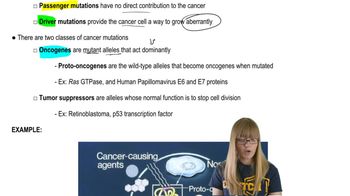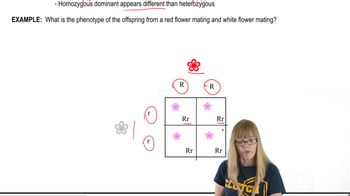Table of contents
- 1. Introduction to Genetics51m
- 2. Mendel's Laws of Inheritance3h 37m
- 3. Extensions to Mendelian Inheritance2h 41m
- 4. Genetic Mapping and Linkage2h 28m
- 5. Genetics of Bacteria and Viruses1h 21m
- 6. Chromosomal Variation1h 48m
- 7. DNA and Chromosome Structure56m
- 8. DNA Replication1h 10m
- 9. Mitosis and Meiosis1h 34m
- 10. Transcription1h 0m
- 11. Translation58m
- 12. Gene Regulation in Prokaryotes1h 19m
- 13. Gene Regulation in Eukaryotes44m
- 14. Genetic Control of Development44m
- 15. Genomes and Genomics1h 50m
- 16. Transposable Elements47m
- 17. Mutation, Repair, and Recombination1h 6m
- 18. Molecular Genetic Tools19m
- 19. Cancer Genetics29m
- 20. Quantitative Genetics1h 26m
- 21. Population Genetics50m
- 22. Evolutionary Genetics29m
17. Mutation, Repair, and Recombination
Types of Mutations
Problem 28i
Textbook Question
Textbook QuestionAmong Betazoids in the world of Star Trek®, the ability to read minds is under the control of a gene called mindreader (abbreviated mr). Most Betazoids can read minds, but rare recessive mutations in the mr gene result in two alternative phenotypes: delayed-receivers and insensitives. Delayed-receivers have some mind-reading ability but perform the task much more slowly than normal Betazoids. Insensitives cannot read minds at all. Betazoid genes do not have introns, so the gene only contains coding DNA. It is 3332 nucleotides in length, and Betazoids use a four-letter genetic code. The following table shows some data from five unrelated mr mutations. Mutation Description of Mutation Phenotype _ mr-1 Nonsense mutation in codon 829 Delayed-receiver mr-2 Missense mutation in codon 52 Delayed-receiver mr-3 Deletion of nucleotides 83–150 Delayed-receiver mr-4 Missense mutation in codon 192 Insensitive mr-5 Deletion of nucleotides 83–93 Insensitive For each mutation, provide a plausible explanation for why it gives rise to its associated phenotype and not to the other phenotype. For example, hypothesize why the mr-1 nonsense mutation in codon 829 gives rise to the milder delayed-receiver phenotype rather than the more severe insensitive phenotype. Then repeat this type of analysis for the other mutations. (More than one explanation is possible, so be creative within plausible bounds!)
 Verified Solution
Verified SolutionThis video solution was recommended by our tutors as helpful for the problem above
Video duration:
1mPlay a video:
Was this helpful?
Key Concepts
Here are the essential concepts you must grasp in order to answer the question correctly.
Gene Mutations
Gene mutations are alterations in the DNA sequence of a gene, which can affect the function of the protein produced. These mutations can be classified into several types, including nonsense mutations, which introduce a premature stop codon, and missense mutations, which result in a different amino acid being incorporated into the protein. Understanding how these mutations impact protein function is crucial for explaining the resulting phenotypes in organisms.
Recommended video:
Guided course

Cancer Mutations
Phenotype Expression
Phenotype expression refers to the observable traits or characteristics of an organism, which result from the interaction of its genotype with the environment. In the context of the Betazoids, the phenotypes of delayed-receivers and insensitives arise from specific mutations in the mindreader gene. The severity of the phenotype often correlates with the type and location of the mutation within the gene, influencing the protein's functionality.
Recommended video:
Guided course

Penetrance and Expressivity
Recessive vs. Dominant Traits
In genetics, traits can be classified as dominant or recessive based on their expression in the phenotype. Recessive traits require two copies of the mutated gene to manifest, while dominant traits can be expressed with just one copy. In the case of the Betazoids, the recessive mutations in the mr gene lead to the delayed-receiver and insensitive phenotypes, illustrating how the inheritance pattern affects the expression of mind-reading abilities.
Recommended video:
Guided course

Variations on Dominance

 9:49m
9:49mWatch next
Master Point Mutations with a bite sized video explanation from Kylia Goodner
Start learning



